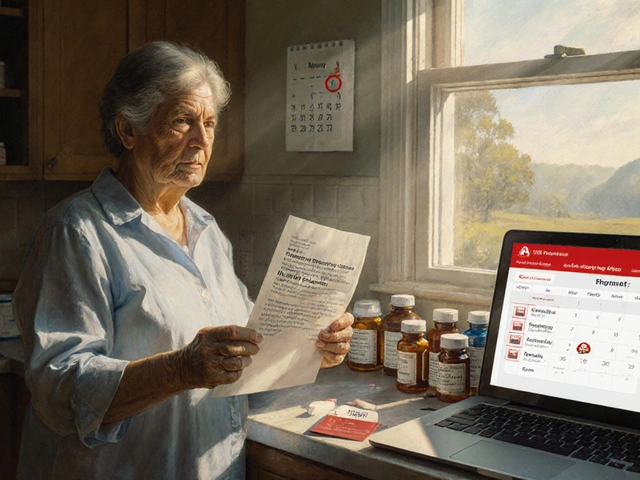Why Medication Adherence Matters More Than You Think
You’ve been prescribed a medication for high blood pressure, diabetes, or cholesterol. Your doctor says it’s life-changing. But if you’re skipping doses, forgetting pills, or stopping early because you feel fine, the medicine isn’t working-even if it’s the best one available. Medication adherence isn’t just about taking pills on time. It’s about staying alive, avoiding hospital visits, and keeping your long-term health on track. The World Health Organization says more than half of people with chronic conditions don’t take their meds as directed. That’s not laziness-it’s a system problem. And the cost? Over $100 billion a year in the U.S. alone from avoidable emergencies and complications.
What Does ‘Adherence’ Really Mean?
Adherence isn’t just whether you took your pill today. It’s three things: initiation (did you start?), implementation (are you taking it right?), and persistence (did you stick with it long enough?). A patient might fill their prescription but never open the bottle. Another might take it daily but skip doses when they feel fine. Both are non-adherent. The goal isn’t perfection-it’s consistency. For chronic meds like statins or blood pressure pills, you need to hit at least 80% adherence over time to see real benefits. That means missing no more than 6 days in a 30-day cycle.
How Do You Know If You’re Adherent?
Doctors can’t read your mind. They rely on tools-and so should you. There’s no single perfect way to measure adherence, but some methods are more honest than others. Here’s what works in real life:
- Pill counts: Your pharmacist or doctor counts leftover pills. Simple, but easy to game.
- Prescription refill records: If you refill your blood pressure med every 30 days, you’re likely taking it. But this doesn’t prove you swallowed it. This is where Proportion of Days Covered (PDC) comes in. It’s the gold standard for chronic meds. If your PDC is 85%, you’re covered 85% of the days you should’ve been taking the drug. Anything below 80% is a red flag.
- Electronic monitors: Some pill bottles have tiny chips that log when you open them. Accurate-but expensive and not widely used outside clinical trials.
- Self-reports: Asking patients if they take their meds? Don’t trust it. Studies show people overreport adherence by up to 40%. You think you’re doing fine, but your body knows the truth.
- Medication Adherence Report Scale (MARS-5): A quick 5-question survey that asks how often you forget, skip, or delay doses. Higher scores = better adherence. It’s not perfect, but it’s cheap, fast, and gives you insight into your own habits.
Your Practical Adherence Checklist
Here’s a simple, no-tech, no-cost checklist you can start today. Use it weekly. It’s based on what works in real clinics-not theory.
- Keep a daily log. Write down each dose you take-even if you’re on a once-daily pill. Use a notebook, phone notes, or a free app like Medisafe or MyTherapy. No judgment. Just record.
- Set a daily alarm. Name it something real: ‘Take BP pill’ not ‘Meds’. Link it to a habit you already do: after brushing your teeth, after breakfast.
- Use a pill organizer. Buy a simple 7-day box with morning/afternoon/evening slots. Fill it once a week. If you see a slot still full on Friday, you missed it.
- Check your refill dates. Mark your calendar when your prescription runs out. Don’t wait until you’re out. Call the pharmacy 3 days before.
- Ask yourself this every Sunday: ‘Did I take all my meds as prescribed this week?’ If the answer is ‘no,’ write down why. Was it cost? Side effects? Forgetting? Confusion? That’s your next step.

What If You’re Not Adherent? Don’t Panic
Missing doses doesn’t make you a bad patient. It makes you human. Life gets busy. Side effects happen. Pills get lost. The key is to talk about it-without shame. Many doctors avoid asking because they fear confrontation. But research shows when you use non-judgmental language like ‘I know taking meds every day is hard. What’s getting in the way?’-patients open up 47% more often. If you’re skipping meds because of cost, ask about generic options. If you’re confused about timing, ask for a written schedule. If you’re afraid of side effects, bring them up. Your health depends on honesty, not perfection.
What Tools Are Actually Available?
You don’t need fancy gadgets. But if you want tech help:
- Smart pill bottles: Brands like AdhereTech have bottles that text you when you miss a dose. They cost $50-$100 and need Wi-Fi or cellular service.
- Apps: Medisafe, MyTherapy, and PillPack (by Amazon) offer reminders, logs, and refill alerts. Most are free.
- Pharmacy services: CVS, Walgreens, and others offer free adherence packaging with pre-sorted doses. Ask your pharmacist.
- Home health visits: If you’re elderly or have mobility issues, some insurance plans cover nurses who check in weekly to watch you take your pills.
Why Your Doctor Might Not Know You’re Struggling
Most doctors rely on refill data. If you refill your statin every month, they assume you’re fine. But if you’re taking it only twice a week, they won’t know. That’s why you need to speak up. In a 2021 survey, 62% of doctors admitted they rarely ask about adherence because they assume patients are compliant. Don’t let that silence hurt you. Be the one to start the conversation.

What’s Changing in 2025?
Health systems are waking up. Medicare now rewards plans that help patients stay on their meds-with bonuses up to $1,200 per person for high adherence. Pharmacies are rolling out AI tools that predict who’s at risk of stopping meds based on refill patterns, social factors, and even weather (yes, rain affects adherence). The FDA now wants adherence data in clinical trials. And the Pharmacy Quality Alliance updated its guidelines in May 2025 to include social factors like transportation, language barriers, and food insecurity. If you’re struggling because you can’t get to the pharmacy or afford your copay, you’re not alone-and now there are systems trying to fix it.
Start Small. Stay Consistent.
You don’t need to be perfect. You just need to be consistent. Even improving from 50% to 65% adherence can cut your risk of hospitalization by 30%. Pick one step from the checklist. Do it for a week. Then add another. Track your progress. Talk to your pharmacist. They’re your best ally-not your judge. Medication adherence isn’t about discipline. It’s about design. Make it easy. Make it visible. And never assume your doctor knows what’s really happening between your pharmacy visits and your checkups.
What’s the difference between medication adherence and compliance?
"Compliance" implies the patient is obedient to the doctor’s orders. "Adherence" is more patient-centered-it recognizes that people make choices based on their lives, beliefs, and challenges. Adherence is the preferred term because it’s less judgmental and more accurate.
Is 80% adherence really enough?
Yes-for chronic conditions like high blood pressure, diabetes, or cholesterol, 80% is the minimum threshold proven to reduce complications. Below that, benefits drop sharply. For example, a 2023 JAMA study showed patients with PDC under 80% had 2.3 times higher risk of heart attack than those above 80%.
Can I just take my meds when I feel sick?
No. Medications like statins or blood pressure pills work over time. Skipping doses because you feel fine lets your condition creep back. You might not feel symptoms, but damage is still happening inside your body.
What if I can’t afford my meds?
Ask your pharmacist about generic versions, patient assistance programs, or 90-day mail-order prescriptions. Many drugmakers offer free or low-cost options. In the U.S., Medicare Part D has a cap on out-of-pocket costs. Don’t skip doses because of cost-there are solutions.
Do I need to track every single pill?
Not forever. But for the first 30 days, tracking helps you spot patterns. After that, check in weekly. If you’re consistently hitting 80%+, you can ease off the log. But if you’re slipping, go back to tracking. It’s a tool, not a punishment.
Next Steps: What to Do Right Now
- Find your most important prescription-likely the one you’ve been on the longest.
- Calculate your PDC: divide the total days you had the drug by the total days you should’ve had it over the last 30 days. If it’s under 80%, make a plan.
- Choose one tool from the checklist: pill organizer, alarm, or daily log.
- Text or call your pharmacist and ask: "Can you check my refill history for [medication]?" They can tell you your adherence rate.
- Next time you see your doctor, say: "I’ve been trying to stay on track with my meds. Can we talk about what’s working and what’s not?"
Medication adherence isn’t about being perfect. It’s about being aware. And awareness is the first step to taking back control of your health.






Andrew Forthmuller
80% is the magic number? That’s it? I’ve been at 72% for 6 months and my BP’s fine. Maybe the number’s wrong.
Danae Miley
Let’s be real - PDC is garbage if you’re refilling early to game the system. I’ve seen patients stockpile meds for 3 months then dump them. Doctors need better tools than refill data. Electronic monitors aren’t perfect, but they’re the only thing that doesn’t lie.
And why is no one talking about the fact that 40% of non-adherence comes from side effects no one asks about? Your doctor prescribes a statin, you get muscle pain, you stop. They never check in. That’s malpractice disguised as protocol.
Adherence isn’t about discipline. It’s about trust. If you don’t trust your doctor or think the meds are doing more harm than good, you won’t take them. No checklist fixes that.
manish kumar
I work in a clinic in Delhi and this is the reality: patients refill their meds but don’t take them because they believe the illness is caused by bad luck or spirits. We use community health workers to explain the science in local languages. No app can fix that. You need people who speak their truth, not tech that speaks English.
Also, many can’t afford to travel to the pharmacy every month. We give them 90-day supplies with color-coded blister packs. Simple. Effective. No smartphone needed.
The real barrier isn’t forgetfulness - it’s poverty, stigma, and lack of access. The checklist is cute, but it assumes you have running water, a phone, and a stable home. Not everyone does.
Adherence isn’t a personal failure. It’s a systemic one. Fix the system, not the patient.
Elizabeth Buján
ok so i’ve been on blood pressure meds for 3 years and i swear i take them but like… i sometimes forget if i took them at 8am or 9am and then i just take them again bc i’m paranoid? is that bad? i feel like my body is like ‘uhhh you’re doing too much’
also i use mythearpy app and it’s literally my only friend sometimes. it sends me little emojis and says ‘you got this’ and i cry a little. not even joking.
also i think the word ‘adherence’ sounds like a prison sentence. can we just say ‘taking your medicine like a boss’? i’m trying to reframe this in my head. i’m not failing, i’m learning.
Ryan Everhart
Wow. A whole article about how to take pills and not a single mention of the fact that most of these meds are overpriced junk designed to keep you dependent. You take your statin, you feel fine, but your cholesterol was never the problem - your diet is. But hey, let’s blame the patient for not swallowing the $500/month capsule.
Also, ‘PDC’? Sounds like a Wall Street metric. Real people don’t calculate percentages. They look at their pill box and go ‘uh… that one’s still full.’
Mark Rutkowski
There’s something deeply human about this whole thing - we’re not machines that beep when we’re supposed to take a pill. We’re creatures of rhythm, mood, grief, joy, chaos. Some days, taking your pill is an act of rebellion. Other days, it’s the only thing that keeps you from disappearing.
Adherence isn’t about compliance. It’s about continuity. It’s about showing up for yourself, even when the world doesn’t. And sometimes, that means missing a dose because you were too tired, too sad, too broke - and still getting up the next day to try again.
That’s not failure. That’s resilience. The checklist? It’s a tool. But the real medicine? Is the quiet courage to keep showing up.
David Barry
Let’s not pretend this is about health. This is a revenue stream. Pharma spends $6B a year on direct-to-consumer ads for chronic meds. Then they sell you a $100 app to track adherence. Then they charge insurers extra for ‘adherence programs.’
The real problem? They make more money when you’re sick than when you’re well. Adherence is a myth sold to make you feel guilty so you keep buying.
And the WHO statistic? 50% non-adherence? That’s because half the population is smart enough to know their meds are doing more harm than good.
vanessa k
I took my BP meds for 11 months straight. Then I missed 4 days because my dog died and I couldn’t get out of bed. I felt like a monster. But my doctor didn’t care. She just said, ‘We’ll adjust your dosage.’
That’s the thing no one says: your mental health is part of your adherence. Grief, anxiety, trauma - they don’t show up on a pill count. But they wreck your routine.
Don’t shame yourself. Talk to your pharmacist. They’ve seen it all. And they won’t judge you for crying while you count your pills.
Erica Cruz
This article is so condescending. Like, wow, you didn’t know you should take your pills? Maybe if your doctor explained why they matter instead of just scribbling a prescription, people wouldn’t need a 2000-word checklist to remember to swallow a capsule.
And calling it ‘adherence’ instead of ‘compliance’? Please. It’s the same thing. You’re just rebranding guilt with woke language.
Also, ‘Medisafe’? That app has more ads than a YouTube video. If you’re that broke you need a free app to remember your meds, maybe you need a new doctor.
Renee Ruth
Someone’s gonna say ‘I’m at 85%’ and act like they won the lottery. Meanwhile, I’m over here missing 10 days because I ran out and couldn’t afford the copay. And now my doctor thinks I’m ‘non-compliant’ and wants to add another med.
It’s not about discipline. It’s about class. The people who can afford pill organizers, apps, and 90-day refills are the ones writing these articles. The rest of us are just trying not to get evicted.
This isn’t a health issue. It’s a poverty issue. And you’re all just here to pat yourselves on the back for remembering to take your pills.
Charles Lewis
It is both a medical and sociological imperative that we address the multifaceted nature of medication adherence, particularly in the context of chronic disease management. The statistical underpinnings of the Proportion of Days Covered metric, while empirically validated in randomized controlled trials, often fail to account for the lived experiences of patients navigating socioeconomic constraints, cognitive load, and polypharmacy. The assumption that a patient’s failure to refill a prescription equates to non-adherence is not only methodologically flawed but ethically negligent, as it conflates logistical barriers with moral deficiency. Moreover, the proliferation of digital health tools - while ostensibly beneficial - often exacerbates the digital divide, rendering them inaccessible to elderly, low-income, or non-English-speaking populations. A truly patient-centered approach must integrate behavioral economics, community health worker networks, and structural interventions - such as sliding-scale pharmacy programs and transportation assistance - rather than placing the burden of systemic failure squarely upon the individual. Adherence is not a personal virtue; it is a social contract that requires institutional support to be fulfilled.
Alyssa Lopez
Why are we letting foreign countries dictate our health standards? India? Seriously? We’ve got AI, smart bottles, and telehealth. Stop making excuses. If you can’t take your meds, maybe you shouldn’t be on them. This is America. We don’t coddle people. Take your pill. Or don’t. But don’t blame the system. Blame yourself.
And stop using ‘social determinants’ as a crutch. Everyone’s got problems. You think the soldiers overseas are worrying about pill organizers? No. They take their meds. Because they’re disciplined.
Arpita Shukla
Wait - you said 80% is enough? But I read a study that said 90% is the real threshold for statins. Which one’s right? And why does no one cite the actual journal? Also, PDC doesn’t account for split pills. If you cut a 40mg pill in half and take 20mg twice, does that count as 2 days? I think this whole thing is a scam.
Also, why is no one talking about the fact that 70% of these meds are just placebos with extra chemicals? I mean, look at the FDA’s own data - half the drugs approved in the last 10 years had no clinical benefit over placebo. So why am I taking them? Who’s really benefiting here?
Danae Miley
Andrew - you’re right. PDC is broken. I refill early to make it look good. My doctor thinks I’m perfect. I’m not. I take half the dose because I can’t afford the full one. And I’m not proud of it.
But I’m telling you now. So you know. And if you’re doing the same - you’re not alone.